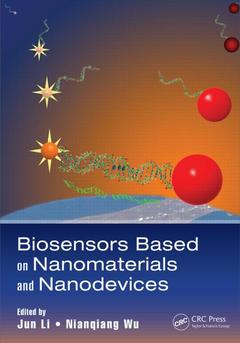Description
Biosensors Based on Nanomaterials and Nanodevices
Nanomaterials and their Applications Series
Coordinators: Li Jun, Wu Nianqiang
Language: English
Subjects for Biosensors Based on Nanomaterials and Nanodevices:
Keywords
SERS Substrate; Transistor; Non-complementary DNA; Spectroscopy; Capture DNA; Quantum Dots; American Chemical Society; Electrochemical Engineering; CVD Diamond; Nanobiotechnology; DNA Hybridization; Nanoparticle; Go; Nanodevice; Target DNA; Nanomaterial; ECL Intensity; Nanotechnology; DNA Functionalization; Nanoscale; Electrochemical Biosensors; Nanoscience; SERS Spectrum; Biomedical Engineering; Photonic Crystals; Biomedical Device; QD Surface; Bioelectronics; NCD; Bioimaging; Ag NPs; Optical Biosensor; AAO Template; Biosensor; Raman Scattering; Sensor; PhC Lattice; surface-enhanced Raman scattering; Fret Biosensor; artificial nanomaterials; PbS QDs; disease diagnosis; PhC Slab; health monitoring; Core Shell QDs; nanostructured biosensors; Photonic Bandgap; Sharp Melting Peaks
Publication date: 01-2014
Support: Print on demand
Publication date: 04-2017
· 17.8x25.4 cm · Paperback
Description
/li>Contents
/li>Readership
/li>Biography
/li>
Biosensors Based on Nanomaterials and Nanodevices links interdisciplinary research from leading experts to provide graduate students, academics, researchers, and industry professionals alike with a comprehensive source for key advancements and future trends in nanostructured biosensor development. It describes the concepts, principles, materials, device fabrications, functions, system integrations, and applications of various types of biosensors based on signal transduction mechanisms, including fluorescence, photonic crystal, surface-enhanced Raman scattering, electrochemistry, electro-luminescence, field-effect transistor, and magnetic effect. The book:
- Explains how to utilize the unique properties of nanomaterials to construct nanostructured biosensors to achieve enhanced performance
- Features examples of biosensors based on both typical and emerging nanomaterials, such as gold nanoparticles, quantum dots, graphene, graphene oxides, magnetic nanoparticles, carbon nanotubes, inorganic nanowires/nanorods, plasmonic nanostructures, and photonic crystals
- Demonstrates the broad applications of nanostructured biosensors in environmental monitoring, food safety, industrial quality assurance, and in vitro and in vivo health diagnosis
- Inspires new ideas for tackling multiscale and multidisciplinary issues in developing high-performance biosensors for complex practical biomedical problems
Focusing on the connection between nanomaterials research and biosensor development, Biosensors Based on Nanomaterials and Nanodevices illustrates the exciting possibilities and critical challenges of biosensors based on nanomaterials and nanodevices for future health monitoring, disease diagnosis, therapeutic treatments, and beyond.
Opportunities and Challenges of Biosensors Based on Nanomaterials and Nanodevices. Synthesis and Characterization of Quantum Dots. Quantum Dots for Bioimaging. Fluorescent Sensors Based on Energy Transfer and Charge Transfer. Graphene-Based Optical Biosensors and Imaging. Biosensing Based on Surface-Enhanced Raman Spectroscopy. In Vivo Biodetection Using Surface-Enhanced Raman Spectroscopy. Photonic Crystal Biosensors. Nanomaterial-Based Electrochemiluminescence Biosensors. Nanocrystalline Diamond Biosensors. Carbon Nanotube-Based Electrochemical Biosensors. Vertically Aligned Carbon Nanofibers for Biointerfacing. Graphene-Based Electrochemical Biosensors. Bioelectronics on Graphene. Nanowire Field-Effect Transistor Biosensors. Biosensing and Cancer Treatment with Magnetic Nanoparticles. Solid-Liquid Phase Change Nanoparticles as Thermally Addressable Biosensors. Microfluidic and Lab-on-Chip Technologies for Biosensors.
Jun Li holds a PhD in chemistry from Princeton University, New Jersey, USA. A recipient of NASA Tech Briefs’ Nano50 Innovator Award, he has engaged in research at Cornell University, Ithaca, New York, USA; Molecular Imaging Inc., Ann Arbor, Michigan, USA; Institute of Materials Research and Engineering, Singapore; NASA Ames Research Center, Mountain View, California, USA; and Kansas State University, Manhattan, USA—where he currently serves as professor. A co-inventor of 15 patents and an associate editor for IEEE Transactions on Nanotechnology, he has published 120 peer-reviewed papers/book chapters and his work has been highlighted in over 40 news reports.
Nianqiang (Nick) Wu currently serves as associate professor for West Virginia University, Morgantown, USA; secretary of the Electrochemical Society’s Sensor Division; and advisory board member for Interface, the home journal of the Electrochemical Society. He holds a PhD in materials science and engineering from Zhejiang University, Hangzhou, People’s Republic of China. Previously he was a postdoctoral fellow at University of Pittsburgh, Pennsylvania, USA and directed Keck Surface Science Center at Northwestern University, Evanston, Illinois, USA. He has organized several symposia on biosensors and solar fuels, holds four patents/disclosures, and has published three book chapters and more than 110 journal papers.
These books may interest you

Nanobiosensors and Nanobioanalyses 158.24 €



